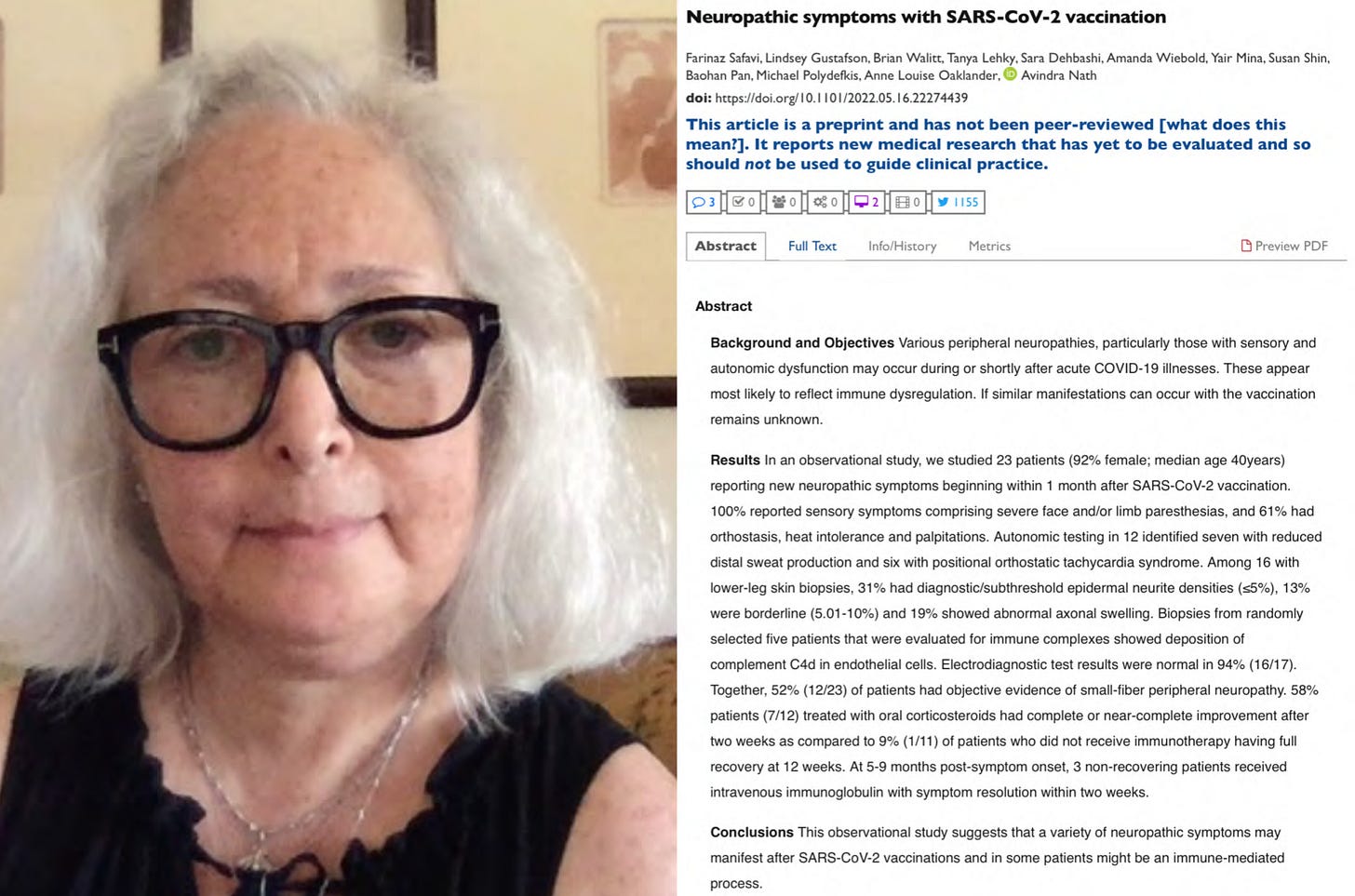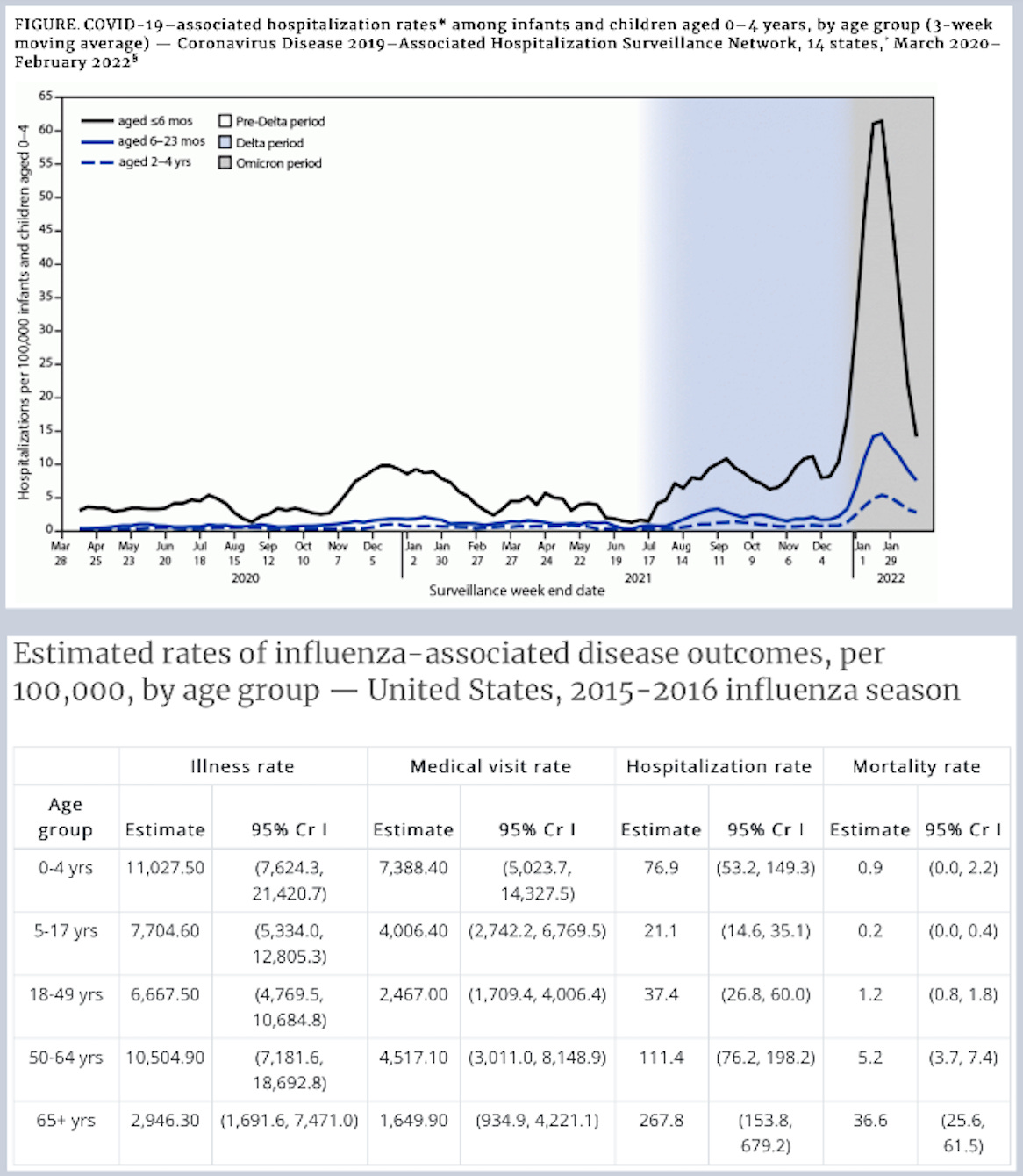Before You Vaccinate Your Child, Consider Five Essential Issues
Think long, weigh the evidence, and seek out good information.
This article is part of a publishing collaboration between RESCUE and Trial Site News.

In his practice, Dr. Syed Haider sees patients every day who have suffered life-altering changes after covid-19 vaccination. Many had not connected their symptoms to the shots.
“Everyone has blinders to vaccine injury,” Dr. Haider told me. “Patients think they drew the one-in-a-million short straw.”
Dr. Haider is one of a savvy if small group of physicians, scientists, and advocates who challenge the vaccine narrative cemented in medicine and media. The vaccinated help themselves and society, it holds; vaccines are safe and effective. End of story.
To be sure, a small minority of 223 million fully vaccinated Americans have reported serious vaccine reactions. But available figures, from a system prone to vast CDC-acknowledged underreporting, show their ranks are large.
As of July 22, the U.S. Vaccine Adverse Events Reporting System, or VAERS, received more than 1.3 million reports of covid vaccine injury, including 29,790 deaths. Our figures include so-called “foreign” reports filed by vaccine makers under law; 13,805 U.S. deaths were reported.
You will not find this tally of complications on the government’s website but rather on a private website called OpenVAERS.com, where it is collated and regularly updated.
For children six months to seventeen years old, the website reported the following “adverse events” through July 22, including foreign and domestic reports:
132 deaths (U.S., 56)
484 permanent disabilities
4,106 hospitalizations
1,868 myocarditis diagnoses
52,654 total injuries
The risks of childhood covid-19 vaccination need to be weighed against the benefits. My compilation here, necessarily succinct, attempts to do that. Click the links. Consider why and why not. Do what has been discouraged: Think it through.
Very few children get seriously ill or die from covid. The risk of covid shots likely outweighs the harm of infection. Two years into this pandemic, the need to inoculate children is nil. Simple as that.
The Five Essentials
ONE: The risk of covid is low.
Data from the U.S. and five other countries show “minimal” risk of covid disease to children, on the order of 0.17 deaths per 100,000 cases, according to an article in BMJ Journal of Medical Ethics. Given that, it concluded, “COVID-19 vaccines are still very likely to be in the best interest of the elderly and more vulnerable, but not of children.”
“Children are overall not becoming seriously unwell with COVID-19,” agreed the Lancet based on data that predated the far less-severe Omicron variant.
A member of the FDA advisory group that voted nineteen to two in favor of vaccinating our youngest citizens was clearly conflicted. Dr. Cody Meissner, a pediatrics professor at Tufts School of Medicine, told the FDA committee that children’s risk of covid hospitalization was akin to being struck by lightning—“a very rare event,” he said.
“I think the vaccine should be available for certainly high-risk children…but I again feel very strongly the parents should understand how small these numbers are—the very low risk from the vaccine, but it’s also a very low risk from the infection itself.”
“I think that has to be communicated clearly to parents,” he said to the committee. Yet the message has been just the opposite.

In support of vaccines for toddlers, the FDA pointed to a “surge” in childhood covid, with an ominous chart showing hospitalizations peaking during Omicron at 14.5 per 100,000 children from six months to four years old. But compare that to figures for influenza disease. In the 2015-16 season, the hospitalization rate for children up to four years old was five times higher, at 76.9 per 100,000—an average, not a misleading peak.
Finally, a just-published British Medical Journal opinion article concluded on childhood covid vaccination, “the vast majority stands little to benefit, and it is ethically dubious to pursue a hypothetical protection of adults while exposing children to harms, known and unknown.”
TWO: Vaccines and oversight of them have failed.
The vaccinated public has been told to accept what is euphemistically called “breakthrough” infection and, as a remedy, take up to four doses of the vaccine. The recognized failure of mRNA vaccines to stop covid spread has set a low bar that Pfizer and Moderna easily scaled for children’s shots.
In the Pfizer trial, children under five were found a month after their second shot to have produced virtually no antibodies to the Omicron variant. The remedy? Add a third shot that, four months after the trial began, finally registered a “robust” Omicron antibody response.
On efficacy, Pfizer claimed 80.3 percent protection against infection in the trial. But the “confidence intervals”—data trustworthiness—were huge and the number of cases low, with seven infections in the placebo group and three among controls. FDA said the results were “determined not to be reliable.” (It’s worth noting that the only severe hospitalization in the trial was in a vaccinated two-year-old.)
Dr. Haider pointed out the elephant in the room that the FDA missed. “Children are 100 times to 1,000 times less affected from covid than adults,” he told me. “The number one problem with the trial: it didn’t have hundreds of thousands” needed to produce meaningful results. The study had about 4,500 children.
The two-shot Moderna results were better than Pfizer for antibody production and efficacy, but were hardly stellar. For example, vaccine efficacy was a barely acceptable 50.6 percent for the six- to twenty-three-month-old group using the CDC covid definition but were a statistically unreliable 31.5 percent using the FDA definition. They ranged from an anemic 36.8 percent to 46.4 percent for the two-to-five age group. Despite all this, the FDA approved both vaccines.
Dr. Mobeen Syed critiqued the trials for his half-million medical education subscribers on YouTube. “I think I should laugh and cry,” he said of his analysis of the FDA approval, which is a must-view. “I think Moderna’s authorization still has some merit although I’m not even comfortable with that. But Pfizer’s authorization just did not make sense at all.” Pfizer’s efficacy data was “all over the map,” he said, saying at another point, “Based on this data, they should have said, ‘No, we should not authorize you yet.’”
Dr. Paul Offit, a prominent member of FDA’s advisory committee who voted against the approval, said bluntly that the FDA review suggested “the fix was in a little bit.”
“I felt like we were being led here with a critical lack of information,” he said in an interview with Dr. Zubin Damania on his ZDoggMD YouTube show.
“It seems like the burden of proof for FDA seems to be going down and down and down,” Damania suggested.
“Exactly,” said Offit.
In the end, a huge assumption sealed the approval: Under a novel concept called “immunobridging,” parallel antibody levels in vaccinated adults would theoretically translate into efficacy in vaccinated children, even when the clinical trials produced weak results.
“They are using bogus data on adults on efficacy and transferring it over to children,” immunology expert James Lyons-Weiler, a biomedical research scientist who has reported on the vaccines, told me. “Imagine if we did that for cancer treatments testing only adults.”
But the best predictor of whether vaccines-for-tots will even work may be in past performance. Consider three studies:
The Pfizer vaccine’s effectiveness “declined rapidly for children, particularly those 5-11 years,” an Omicron study by New York State officials found, with “low protection” one month after two doses. At thirty-five days post-inoculation, efficacy went negative for five- to eleven-year-olds, meaning increased likelihood of infection.
Even the CDC owned up in the Journal of the American Medical Association: Protection against Omicron for children five to fifteen, its study showed, was “modest and decreased rapidly.”
A new Singapore study, addressed further below, found efficacy of two doses was 48.8 percent just one to two weeks after dual vaccination; it declined to 25.6 percent at two months, meaning only one in four infections avoided.
THREE: The risk is likely greater than the benefit.
Infant and child vaccinations are now permitted under an emergency use authorization, which allows “unapproved medical products…to be used in an emergency to diagnose, treat, or prevent serious or life-threatening diseases or conditions…[if] there are no adequate, approved, and available alternatives.” This begs the question, is covid an emergency for babies who hardly ever get severely ill?
Consider a July 20 New England Journal of Medicine article. In favor of shots, it reported a lower hospitalization rate among about 200,000 fully or partially vaccinated children five to eleven years old, compared to 50,000 who were unvaccinated.
But the Singapore study’s conclusions glossed over another crucial comparison:
Among vaccinated children, twenty-two suffered unspecified “serious adverse events,” and three with covid were admitted to intensive care units.
Among the unvaccinated, obviously, no children suffered vaccine injuries, and just one unvaccinated child was admitted to the ICU.
Typical of many vaccine reports, the paper failed to assess one risk against the other, focusing instead only on covid. Covid hospitalization overall was low but not insignificant—288 among the 53,000 infections. However, it is well established that many hospitalized patients are found to have covid infections that are incidental to the main reason for admission. Further, “We admit children much more readily than adults…we just don’t take any chances with children,” said John Campbell, a nurse educator, in an analysis of the study for 2 million YouTube watchers. “There’s no evidence here that vaccination provides protection” against the most serious covid outcomes.
FOUR: Vaccine harm is minimized.
In February 2022, the Archives of Pathology & Laboratory Medicine reported on two teenage boys who died “suddenly and unexpectedly in their sleep without resuscitation” three and four days after their second Pfizer vaccines. “Neither boy complained of fever, chest pain, palpitations, or dyspnea (labored breathing),” two physicians wrote, warning of the atypical nature of the heart inflammation, called myocarditis, that killed these boys.
The CDC responded by asserting the boys had likely died of other causes. Similarly, when a prominent cardiologist and a prominent immunologist, Dr. Peter McCullough and Jessica Rose, reported that myocarditis rates in VAERS data were “significantly higher in youths between the ages of 13 to 23,” the paper was forced to be withdrawn. This is all part of a larger effort to fight “vaccine hesitancy” by suppressing criticism and failing to acknowledge harm. Case in point: Dr. Pierre Kory, president of Front Line COVID-19 Critical Care Alliance, said in a video interview that “more than one patient” told him of doctors who refused to treat them for what they believed were vaccine injuries.
Post-vaccination myocarditis is one of few adverse events to be widely acknowledged, with a rate 133 times higher in vaccinated teenage boys. While the CDC says that rate is “rare,” the future of children with myocarditis and the prevalence of this and other vaccine injuries is largely guesswork. “Fewer than 1% of vaccine adverse events are reported,” concluded a 2009 report of electronic medical records performed for the government.
Far from being stacked with suspect reports, the digital reporting system is time-consuming, technical, and difficult to navigate. “You’ve got to be quite a specialist clinician to do it,” remarked Campbell in an analysis of Israel’s myocarditis rates.
“There are adverse reactions that can be very serious, as serious as death,” Dr. Danice Hertz, a Los Angeles gastroenterologist, told me. “To be told it is completely safe, it’s just not true…I believed the FDA.”
FIVE: Government is failing to monitor harm.
Thirty minutes after her first Pfizer shot, Hertz, now sixty-five, was so dizzy and breathless that paramedics were called. Nineteen months and twenty-two doctors later, she described herself to me as “incapacitated and in agonizing pain.” After many appeals to the National Institutes of Health, Hertz was enrolled in early 2021 in what is still the only official study of vaccine injured people.
A table in the study—in which twenty-three people were enrolled—states that eleven patients were untreated; and it claims that of the twelve other seriously injured patients in the study, ten achieved “full recovery after 12 weeks” of steroidal or intravenous immunoglobulin therapy. That is false, Hertz says. She and another patient, Brianne Dressen, have formed a vaccine injury group; they know of ten people in the study, including themselves, who continue to have severe neuropathic symptoms. Perhaps two of those ten were in the untreated group. “Nobody is better,” Dressen told me.
A statistical method exists, known as Proportional Reporting Ratio, to pick up above-normal rates of illness after vaccination. In the CDC’s “Standard Operating Procedures” for covid vaccine oversight was this commitment in January 2021: “The CDC will perform PRR data mining on a weekly basis or as needed.” But in response to a Freedom of Information Act request, the agency wrote on June 16, “(N)o PRRs were conducted. Furthermore, data mining is outside the CDC’s purview.”
Perhaps it is true, as CDC analysts wrote in a Lancet article last March, “Safety monitoring of COVID-19 vaccines has been the most comprehensive in US history.” The question is: What is the CDC doing with the data? In the first six months of the vaccine rollout, the CDC article said, there were 4,496 deaths and 22,527 serious injuries. But the study did not try to resolve the essential cause-and-effect question, nor did it say, in an article that used the word safety twenty-three times, that the data showed the vaccines are safe.
Instead, it concluded with the vague assertion that “most reported adverse events were mild and short in duration.” The term “most” was derived by dividing the number of injuries by the number of vaccinations. The analysis is based on a false premise, however. We know the number of vaccinations. We do not know the full number of injuries. Beyond this, while most harms may be minor, how many deaths and permanent injuries are acceptable?
“After fifty deaths the products should have been pulled off the market,” Dr. McCullough told me in response to the CDC data review. “The large numbers of deaths reported in this study”—more than 4,000 then and 29,000 now— “are just the tip of the iceberg.”
What other issues need exploration?
Consider this is a primer on some issues surrounding childhood vaccination. More broadly, evidence points to other serious problems related to repeated, and unsustainable, mRNA vaccinations: Does mass vaccination help spur new variants in a pathogen trying desperately to survive? Does the mRNA vaccination regimen turn the human immune system on itself, causing autoimmunity? Does it stunt the developing immune system of children, for which exposure to pathogens, covid included, is a learning experience that lasts a lifetime? Is it actually prolonging the pandemic?
Those are issues for another article. For this research, I read openvaers.com filings on child vaccine deaths. Here is a selection:
A Georgia boy, sixteen, who suffered “headache and gastric upset over 2 days following second dose. Then felt fine. Found the following day dead in bed.”
A Texas girl, eight, who suffered multi-system inflammatory disease seventy days post-vaccination, with carditis in her heart and inflammation in intestines, lungs, skin, and liver. Her belly distended and lungs filled with fluid, she went to ICU. “(H)er heart stopped beating right there.”
A Wisconsin girl, sixteen, suffered heart failure and pulmonary embolism nine days after her second dose; she died two days later, with an oral contraceptive possibly contributing.
A Colorado boy, fifteen, died of heart failure one day after his first dose.
A Florida boy, one year old, suffered “increased body temperature, seizure, death” two days after his first dose.
An Iowa girl, five, who had an unspecified “complex” medical history, stayed overnight in a hospital as a precaution after the first dose. Two days later, “she was found pulseless and not breathing” at home.
Deaths like this are seldom reported in the popular press, not even to explore the question of potential vaccine harm. Instead, censorship and relentless pro-vaccine messaging suppress necessary information. That’s why I write this article. It may be tagged “misinformation.” It will keep me firmly among the banished of mainstream journalism.
After reading the studies cited here and many more beyond, I’m fine with that.





Thanks, Mary Beth, for another important and courageous contribution to the national dialogue about vaccines that the federal health bureaucracy has tried so hard to stifle. Revelations such as yours are what has prevented them from succeeding-- and are likely to save any number of children from having their health compromised (and perhaps even their lives sacrificed) on the altar of Big Pharma's bottom line.
Mary Beth WELCOME BACK! Such a well written article expresses the reality, backed by your substantiated data, educates us and brings us into the emotional reality of how warped Medical unLeadership has become. TYVM Bruce L Boros MD FACC